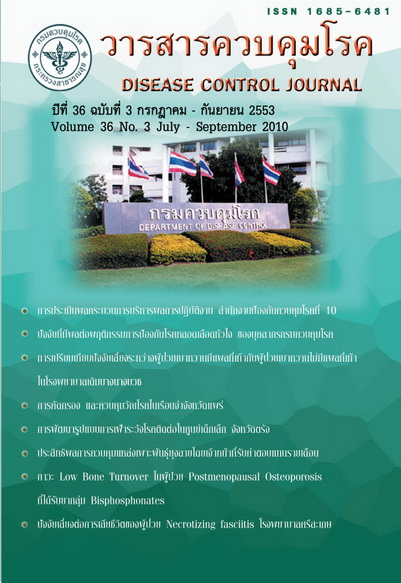Tuberculosis Screening and Control in Phrae Prison
Keywords:
Tuberculosis, Prison, TB screeningAbstract
The stop TB strategy was launched in Thailand in 2006. We emphasized the detection of TB cases in high risk group, this included screening tuberculosis in prison. This study was aimed to measure prevalence and incidence of TB in prison and to compare TB incidence between TB in prison and in the community. Risk group of tuberculosis among prisoners was identified by questionnaires. Those with at least one risk questionnaire, sputum would be collected with chest radiograph. Pulmonary TB were treated if they had smear positive or chest X-ray was compatible with pulmonary TB. New prisoner would be screened for TB before entry. The result revealed that out of 705 prisoners, 182(25.8%) were identified as high risk group and provided with CXR, 16 films were compatible with PTB (6 old PTB, 1 NTB, 1 COPD, 8 new PTB). There were 107 cases with sputum collected of which 2 of them had smear positive. The prevalence was 19.86/1000, incidence was 11.35/1000. Prisoners had up to 7.99 times at risk to have TB more than civilians (95% CI 3.62-16.88). In conclusion, tuberculosis prevalence and incidence in prison remained higher than that in the community. We could detect TB cases with chest radiograph more than sputum examination. The screening strategy by CXR was useful to detect TB in prison, but further investigation with bacteriological confirmed should be done. The strategy presented an opportunity to treat and provide prevention of TB in prison.
Downloads
References
1999; 282(7): 677-86.
2. Chee CB, Teleman MD, Boudville IC, Wang YT. Contact screening and latent TB infection treatment in Singapore correctional facilities. Int J Tuberc Lung Dis. 2005; 9(11): 1248-52.
3. Legrand J, Sanchez A, Le Pont F, Camacho L, Larouze B. Medeling the Impact of Tuberculosis Control Strategies in Highly Endemic Overcrowded Prisons. PLoS One. 2008; 3(5): e 2100.
4. Habeenzu C, Mitarai S, Lubasi D, et al.Tuberculosis and multiple resistance in Zambian prisons, 2000-2001. Int Tuberc Lung Dis. 2007; 11(11): 1216-20.
5. World Health Organization. Global tuberculosis control, country profile Thailand report 2008.
6. Jittimanee SX, Ngamtrairai N, White MC, Jittimanee S. A prevalence survey for smearpositive teberculosis in Thai prisons. Int J Tuberc Lung Dis. 2007; 11(5): 556-61.
7. Pleumpanupat W, Jittimanee S, Akarasewi P, Rienthong S, Chiewlian Y, Phumpuk S, Malainual C, Ngamtrairai N, Adedipe A. Resistance to anti-tuberculosis drugs among smearpositive cases in Thai prisons 2 years after the implementation of the DOTS strategy. Int J Tuberc Lung Dis. 2003; 7(5): 472-7.
8. Sretrirutchai S, Silapapojakul K, Palittapongarnpim P, Phongdara A, Vuddhakul V. Tuberculosis in Thai prisons: magnitude, transmission and drug susceptibility. Int J Tuberc Lung Dis. 2002; 6(3): 208-14.
9. Aerts A, Hauer B, Wanlin M, Veen J. Tuberculosis and tuberculosis control in European prisons. Int J Tuberc Lung Dis. 2006; 10(11): 1215-23.
10. World Health Organization. Global tuberculosis control report 2008.
Downloads
Published
How to Cite
Issue
Section
License
Articles published in the Disease Control Journal are considered as academic work, research or analysis of the personal opinion of the authors, not the opinion of the Thailand Department of Disease Control or editorial team. The authors must be responsible for their articles.






